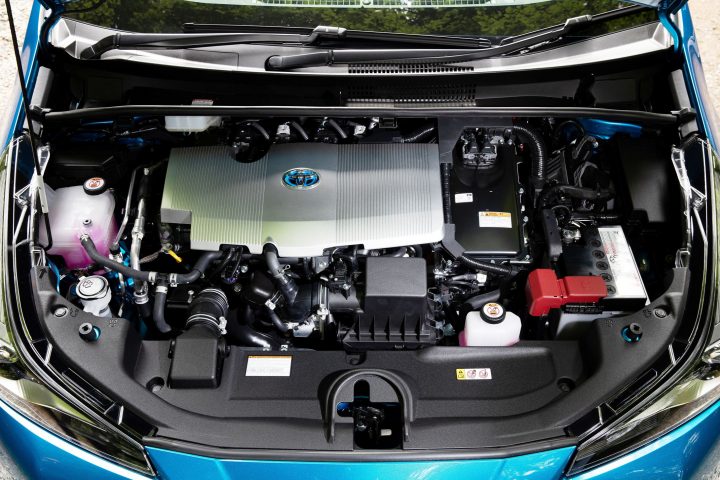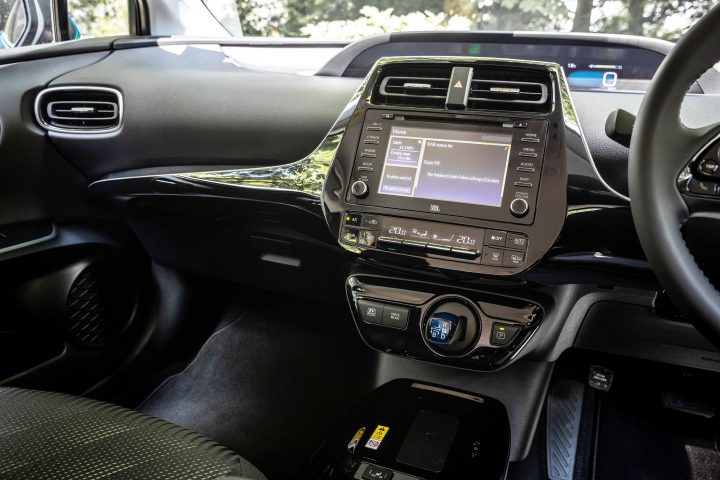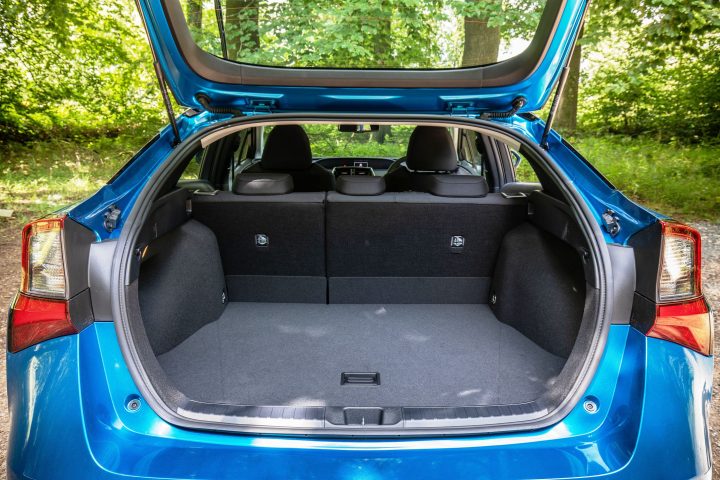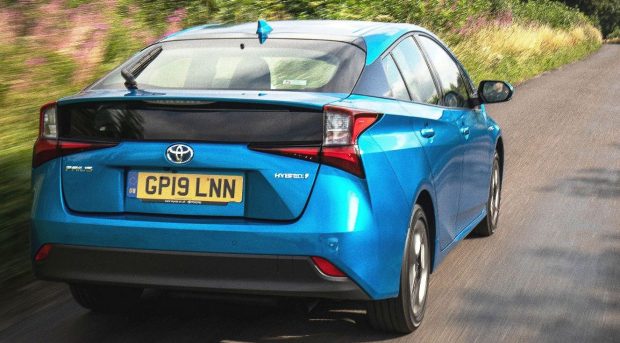 Launched about a year ago was the new fourth generation Toyota Prius which had first use of Toyota’s New Global Architecture platform which in the case of the Prius lowered the ride height, gave a more engaging drive and improved the interior quality, writes David Miles.
Launched about a year ago was the new fourth generation Toyota Prius which had first use of Toyota’s New Global Architecture platform which in the case of the Prius lowered the ride height, gave a more engaging drive and improved the interior quality, writes David Miles.
It also introduced to the Prius brand a more acceptable exterior body style now similar to subsequent other new Toyota models such as the C-HR, Corolla and Camry ranges.
The first generation petrol-electric hybrid Prius was launched in 1997 in Japan and subsequently 2000 in the UK and it has become the World’s best selling self-charging hybrid car. In its latest line-up an intelligent all wheel drive (AWD-i) version has been included and it’s this version we are trying this week.
The AWD version is only available with one specification level, the Prius Business Edition Plus which tells us the targeted probable main users. These will be UK company car drivers and of course Uber taxi and other private hire operators who perhaps operate in areas more affected by snowy and icy road conditions. And it’s not as if the AWD-i system turns the Prius five door mid-sized hatchback model into a version with potential to tackle any light off-road travel either. Yes it should cope with a grassy car park or a rutted track but the AWD-i system is only really about extra grip on start off driving acceleration and stabilising rear end grip if the main driving front wheels start to slip on adverse road surfaces at relatively low speeds. The AWD-i systems equips the Prius with an additional, independent magnet-less electric motor and inverter located on the rear axle and powered by the hybrid battery. The system automatically engages all the time to provide additional drive to the rear wheels when pulling away at speeds up to 6mph. At higher speeds – between 6 and 44mph – it will only come into play transferring torque to the rear axle when sensors detect a loss of grip at the front wheels. The operation is automatic and on-demand so the driver does not have to select AWD. The system does not operate in normal driving conditions or under braking. Unlike mechanical AWD systems there is no driveshaft between the front and rear axles and no centre differential. This saves some weight and takes up less space. Its installation only reduces boot space by 45-litres to 412-litres while retaining a flat load area floor. The compact rear electric motor produces a maximum 5.3kW – around 7bhp but delivers high wheel torque of 570Nm with a 10.4 reduction ratio. The Combined Cycle WLTP fuel consumption is 58.7 to 64.7mpg and on my week long period of driving this model the real-life figure was 58.5mpg.By comparison the official WLTP Combined Cycle figures for front wheel drive versions is 59.6 to 68.35mpg. | The Prius Business Edition Plus AWD-i model costs £28,970, but that’s £1,650 more than the equivalent specification Prius without the AWD function. The mainstream Prius range of models, whatever the spec levels, use Toyota’s renowned self-charging hybrid system comprising of a 1.8-litre petrol engine plus electric motors with a CVT automatic transmission with a total power output of 122bhp. Prices start for the usual front wheel drive models from £24,245 for the Active spec level and rise up to £28,355 for the Excel version. But the AWD version tops the line-up price-wise at £28,970. There are also 2WD Prius PHEV plug-in hybrid models using the same 1.8 petrol engine/hybrid powertrain and these cost over £32k plus there is the Prius + MPV 7-seat range again using the 1.8-litre hybrid system priced from £28k, also 2WD. As for tax costs most mainstream Prius hatchback two wheel drive versions have CO2 emissions of 75g/km so First Year VED road tax costs £15 and Benefit-in-Kind company car tax is 19%. However the AWD-i version has CO2 emissions of 85g/km due to its 60kg heavier weight so VED costs £100 and BiK rises to 22%. So the Prius AWD not only costs more to buy it has higher tax costs as well compared to conventional front wheel drive hatchback versions. |
 Up front, as with other Prius models, the drivetrain uses the latest improved 1.8-litre 4-cylinder Atkinson cycle petrol engine which produces 97bhp and peak torque of 142Nm.
Up front, as with other Prius models, the drivetrain uses the latest improved 1.8-litre 4-cylinder Atkinson cycle petrol engine which produces 97bhp and peak torque of 142Nm.
It is mated with a new lightweight transaxle housing two electric motors.
One operates primarily as a generator converting surplus power from the engine into electricity which is stored in the battery pack. It also operates as the engine’s starter motor. The second electric motor is the drive motor which also acts as a generator when the car is in regenerative braking mode. This motor drives the car from start-up at low speed and in EV (electric power only mode) and it is the sole power driver when the vehicle is reversed. The full petrol/electric hybrid system power output is 122bhp.
 The AWD-i Prius can drive on electric power only at speeds up to 36mph but only for very short distances and it will use electric power only for initial start-off or when the EV button is pressed to select electric drive mode. After the electric current is used up the petrol engine chimes into life.
The AWD-i Prius can drive on electric power only at speeds up to 36mph but only for very short distances and it will use electric power only for initial start-off or when the EV button is pressed to select electric drive mode. After the electric current is used up the petrol engine chimes into life.
In normal driving operation the Prius AWD-i has a top speed of 99mph with the zero to 62mph acceleration time of 10.9-seconds, both a shade slower than two wheel drive versions but hardly enough to make a real difference in today’s motoring conditions.
In real-life driving conditions the AWD-i version is no different to any other Prius. The powertrain is seamless and smooth and other than under hard acceleration – respectably quiet. It cruised happily at 70mph and coped without any fuss or drawbacks with country road driving or pottering around in busy stop/start town traffic. In truth I never felt the additional rear wheel electric drive system working and unless I lived in a house with a steep driveway – snow covered in winter – I do not feel it offers any real benefits and it costs more to buy and run.
On one occasion I had a long motorway journey in torrential rain conditions with standing water on a motorway and after that huge puddles on country roads. Because the rear wheel AWD system doesn’t operate above 44mph it gave no extra driving confidence of sure-footedness. In other countries with tougher winter conditions the Prius AWD-i might offer some advantages but in reality in the UK for the majority of the time it’s not worth the extra money.
 The conventional Prius hybrid 2WD models are just fine, frugal, cost effective to buy and run, easy to drive, roomy and comfortable models. Best of all self charging petrol electric self charging hybrids give their users no driving range anxieties and there is no need to find an electric charging point or mess with plug-in cables on wet/muddy days.
The conventional Prius hybrid 2WD models are just fine, frugal, cost effective to buy and run, easy to drive, roomy and comfortable models. Best of all self charging petrol electric self charging hybrids give their users no driving range anxieties and there is no need to find an electric charging point or mess with plug-in cables on wet/muddy days.
All the latest Toyota Prius models now have as less quirky body style; they look really smart with a wedge shape side profile whilst retaining its aerodynamic steeply sloping rear tailgate with its twin rear windows. Towards the front are sharp styling lines giving it a characterful appearance rather than the previous bland models. The new Prius competes more happily style wise with other family sized hatchbacks which is now a must as hybrid and pure electric models enter the mainstream new car market.
 Inside there has been a general upgrading of the ambience and quality of the upholstery, trim materials and infotainment and connectivity functions. It just looks and feels a classier product and well suited to a wider audience than when previous Prius versions which only appealed to ‘eco-warriors’.
Inside there has been a general upgrading of the ambience and quality of the upholstery, trim materials and infotainment and connectivity functions. It just looks and feels a classier product and well suited to a wider audience than when previous Prius versions which only appealed to ‘eco-warriors’.
As with all Prius models, the Prius Business Edition Plus AWD-i variant has Toyota’s Safety Sense Pre-Collision System which consists of pedestrian protection, adaptive cruise control, lane departure alert, automatic high beam headlights and road sign assist.
 The specification has everything the business user or retail customer needs such as dual zone climate control, Toyota Touch 2 with Go Navigation, (not the best display system on the market), rear view camera, wireless phone charger, blind spot monitor, rear cross traffic alert, heated and folding door mirrors, LED lights, 17-inch alloys and electric windows.
The specification has everything the business user or retail customer needs such as dual zone climate control, Toyota Touch 2 with Go Navigation, (not the best display system on the market), rear view camera, wireless phone charger, blind spot monitor, rear cross traffic alert, heated and folding door mirrors, LED lights, 17-inch alloys and electric windows.
 Throw in good visibility, a generally comfortable ride quality, roomy cabin and good rear seat legroom, good real-life fuel economy and low tax costs, appealing sharp exterior styling and the latest Prius is to be recommended.
Throw in good visibility, a generally comfortable ride quality, roomy cabin and good rear seat legroom, good real-life fuel economy and low tax costs, appealing sharp exterior styling and the latest Prius is to be recommended.
But I cannot justify the AWD-i version because of the added purchase price and higher tax costs for the marginal advantage of limited added traction.
MILESTONES:
Toyota Prius Business Edition Plus AWD-i petrol-electric hybrid hatchback £28,970
Powertrain: 1.8-litre, 4-cylinder normally aspirated petrol engine, two front electric/generator motors plus rear axle electric AWD-i motor, CVT automatic transmission, total power output 122bhp
Performance: 99mph, 0-62mph 10.9-seconds, WLTP Combined Cycle 58.7 – 64.7mpg (58.5mpg on test)
CO2 85g/km, VED First Year road tax £100, Standard rate £135, BiK company car tax 22%
Insurance group: 14E Warranty: 5-years/100,000-miles
Dimensions/capacities: L 4,575mm, W 1,760mm, H 1,475mm, wheelbase 2,700mm, boot 412-litres, 50doors/5-seats
For: Smart new looks, upgraded interior ambiance and equipment, roomy, comfortable, good real-life fuel economy, no driving range anxieties, reasonable tax costs, good warranty.
Against: The limited AWD-i added grip function is not worth the extra cost and higher tax costs in the UK market over a conventional front wheel drive model, clunky to use sat-nav system, unsettled ride over poorer road surfaces.
© David Miles


